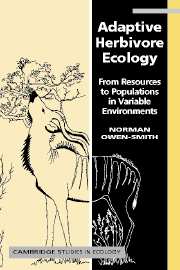Book contents
- Frontmatter
- Contents
- Acknowledgements
- Acronym and symbol conventions
- 1 Conceptual origins : variability in time and space
- 2 Consumer–resource models : theory and formulation
- 3 Resource abundance : intake response and time frames
- 4 Resource distribution : patch scales and depletion
- 5 Resource quality : nutritional gain and diet choice
- 6 Resource constraints : physiological capacities and costs
- 7 Resource allocation : growth, storage and reproduction
- 8 Resource production : regeneration and attrition
- 9 Resource competition : exploitation and density dependence
- 10 Resource-dependent mortality : nutrition, predation and demography
- 11 Habitat suitability : resource components and stocking densities
- 12 Resource partitioning : competition and coexistence
- 13 Population dynamics : resource basis for instability
- 14 An adaptive resource ecology : foundation and prospects
- References
- Index
2 - Consumer–resource models : theory and formulation
Published online by Cambridge University Press: 04 February 2011
- Frontmatter
- Contents
- Acknowledgements
- Acronym and symbol conventions
- 1 Conceptual origins : variability in time and space
- 2 Consumer–resource models : theory and formulation
- 3 Resource abundance : intake response and time frames
- 4 Resource distribution : patch scales and depletion
- 5 Resource quality : nutritional gain and diet choice
- 6 Resource constraints : physiological capacities and costs
- 7 Resource allocation : growth, storage and reproduction
- 8 Resource production : regeneration and attrition
- 9 Resource competition : exploitation and density dependence
- 10 Resource-dependent mortality : nutrition, predation and demography
- 11 Habitat suitability : resource components and stocking densities
- 12 Resource partitioning : competition and coexistence
- 13 Population dynamics : resource basis for instability
- 14 An adaptive resource ecology : foundation and prospects
- References
- Index
Summary
This chapter outlines the theory, principles and concepts that underlie models of consumer–resource dynamics. We establish first the foundation in terms of the fundamental biological laws that apply to all organisms, and clarify the distinction between processes occurring in ecological versus evolutionary realms. This relates in particular to the currency to be used for the state variables in the models.
The kinds of consumers we have in mind in this book are large mammalian herbivores, with the resource constituted by vegetation. Starting from the simplest phenomenological models, we work upwards towards models of interactive herbivore–vegetation dynamics. Caughley's (1976a) classical model is elaborated further, drawing upon metaphysiological modelling concepts developed by Getz (1991, 1993). The three functional components contributing to herbivore biomass change -resource gains, metabolic attrition and mortality losses – are distinguished in formulating the GMM metaphysiological model of herbivore dynamics. The potential of this model to accommodate seasonal variability in resource production, as well as other environmental influences on herbivore population changes, will be outlined.
Some of the mathematical terminology and functions that will be adopted in the remainder of the book will be introduced. This sets the stage for the chapters that follow, which will explore in more detail the processes underlying population responses to spatial and temporal variability in environments.
- Type
- Chapter
- Information
- Adaptive Herbivore EcologyFrom Resources to Populations in Variable Environments, pp. 13 - 37Publisher: Cambridge University PressPrint publication year: 2002



